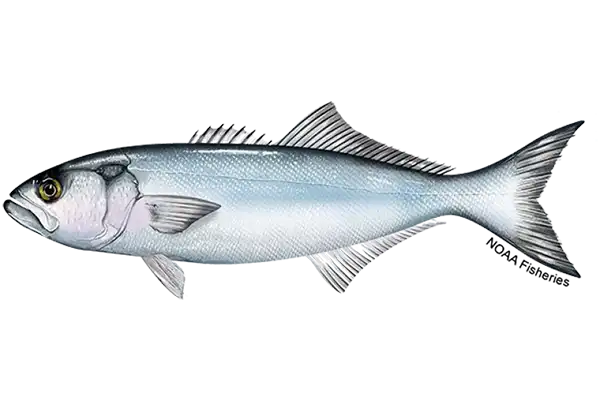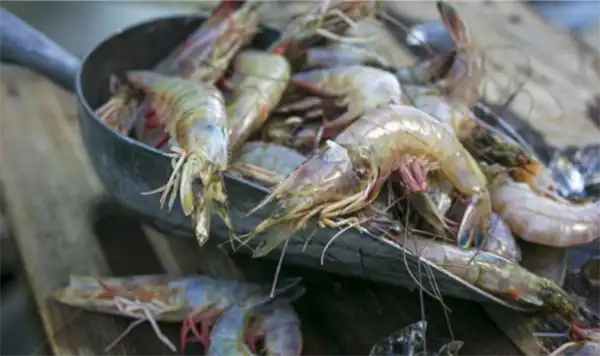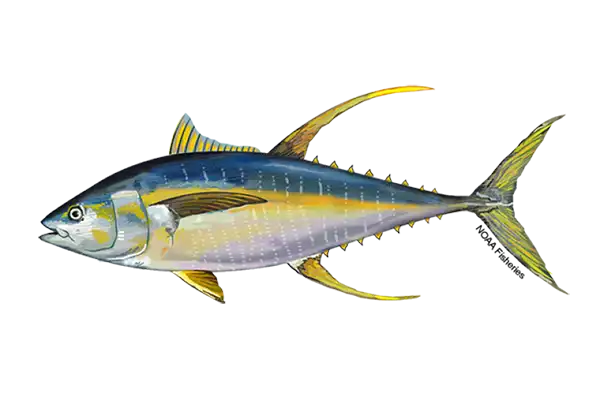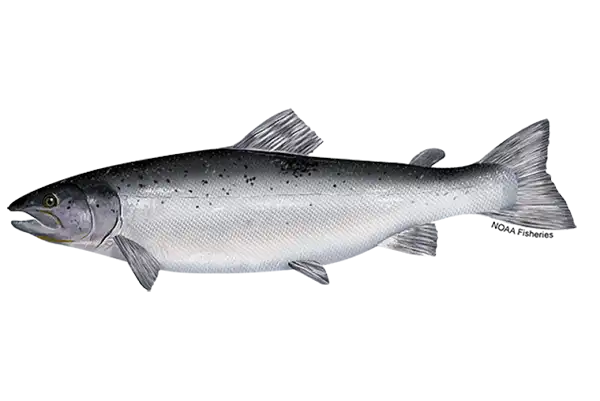Locally Caught Fresh Fish
The following fisheries can be found in the Gulf of Maine and may be weekly CSF species caught by our local fishermen. For additional seafood information and recipes, please visit NOAA Sustainable Seafood Profiles.

Acadian Redfish
Acadian redfish or ocean perch are a slow-growing, long-lived deepwater fish of rocky, mud, or clay bottom habitats. They are found from Iceland to the mid-Atlantic and are common in deep waters of the Gulf of Maine, although they move closer to shore in the winter. Acadian redfish grow slowly and can live up to 58 years of age. Fishing in the 1930s and 1940s led to a decline in the size of the population. However, the stock has increased in recent years due to sustainable fisheries management. The redfish population in US waters is currently at healthy levels.
Redfish has a mild and sweet flavor and a medium-firm texture. When raw, the flesh appears to be creamy or off-white but turns white once cooked. They have a smooth texture that is perfect for most recipes.
Typical cooking methods include baking, deep-frying, poaching, sauteing and steaming.

Blackback Flounder
Blackback flounder, also known as Pseudopleuronectes americanus, are flatfish indigenous to the Northwest Atlantic Ocean, predominantly inhabiting the Gulf of Maine and Georges Bank. Their bodies are flattened and oval-shaped, with eyes positioned on the right side. The upper side of blackback flounder typically displays a dark brown or blackish hue, contrasting with a white or pale underside. Their skin is smooth, occasionally adorned with small spots or patches.
In terms of taste, blackback flounder offer a delicate, mild flavor with subtle sweetness. Their meat is tender and flaky, ideal for various cooking methods such as frying, grilling, baking, or steaming. With their ability to complement a range of seasonings and sauces, blackback flounder provide a versatile culinary experience, appreciated by those who enjoy subtle flavors and tender textures. Overall, blackback flounder offer a light and enjoyable seafood option, perfect for those seeking a mild and satisfying dining experience.

BlueFish – Scrombic
Bluefish possess a distinct appearance with their sleek, torpedo-shaped bodies adorned in shades of bluish-green to greenish-gray on the dorsal side, while displaying a silvery white underside. Characterized by a prominent dorsal fin and a deeply forked tail, they boast a formidable presence in coastal waters. Their large mouths, filled with sharp, triangular teeth, signify their role as voracious predators in the marine ecosystem.
In terms of taste, bluefish offer a rich and full-bodied flavor with a moderately oily texture. Their firm, succulent meat provides a satisfying culinary experience, often described as bold and assertive, appealing to seafood enthusiasts who appreciate robust flavors. Whether grilled, baked, or smoked, bluefish deliver a delicious meal, showcasing the unique taste of the sea.

Dab
Dab fish, also known as European dab or Limanda limanda, are flatfish found in the Northeast Atlantic and North Sea. They possess flattened, diamond-shaped bodies with both eyes located on the right side, enabling them to camouflage with the sandy seabed where they reside. Typically sandy-brown or yellowish on the upper side and white or pale underneath, dab fish have smooth skin with occasional small spots or patches.
In terms of taste, dab fish offer a delicate, mild flavor with a subtle sweetness. Their meat is tender and flaky, making it suitable for various cooking methods such as frying, grilling, baking, or steaming. Dab fish pair well with a range of seasonings and sauces, offering a versatile culinary experience. Overall, dab fish provide a light and enjoyable seafood option appreciated by those who prefer subtle flavors and tender textures.

Grey Sole
Grey sole, also known as witch flounder, are a flat fish with a very small mouth and both eyes on the top side of their body. They are deep-water fish that are typically brown to gray on top with a vibrant white under belly. This allows them to easily camouflage themselves from predators. They are bottom dwellers, propelling themselves with a wave like motion along the sandy bottom of the sea. Grey sole can grow in length to more than 40 inches but more often are spotted at sizes nearing 2 feet
Grey sole is very lean and easily prepared; simply broiled or elegantly stuffed with crabmeat. The meat of the gray sole is considered to be of high quality in flavor and texture. Typical cooking methods include baking, pan frying, poaching, sauteing and steaming.

Haddock
Haddock is a member of the cod family with a mild flavor, firm flesh and moist texture. They are used interchangeably with cod but have a slightly sweeter taste, which makes them the best white fish for smoking and popular in fish and chips.
Haddock are a North Atlantic white fish with a very distinctive black blotch, known as the “Devil’s thumbprint” just above the pectoral fin and an easily recognizable black lateral line running down their side. They have a purplish-gray coloured head and back that gives way to silvery gray with a pinkish tinge and a white belly. They are an elongated fish with a forked tail and three dorsal fins. This deep-sea fish, typically weighing from 2 to 7 pounds, is prolific along the coasts of both North America and Europe.
Typical cooking methods include baking, broiling, deep frying, poaching, sauteing and smoking.

Hake
Hake is a lean white fish that is part of the cod family. Their mild flavor and delicate texture make them a popular seafood choice in the United States and Europe.
They are a medium to large fish averaging from one to 8 pounds in weight, with specimens as large as 60 pounds. The fish can grow up to 3 ft 3″ in length with a lifespan as long as 14 years. Hake may be found in the Atlantic Ocean and Pacific Ocean in waters from 660–1,150 ft deep. The fish stay in deep sea water during the day and come to shallower depths at night. An undiscerning predator, hake feed on their prey found near or on the bottom of the sea. Male and female hake are very similar in appearance.
Typical cooking methods include baking, broiling, deep frying, sauteing, smoking and steaming.

King Whiting
Regarded as one of the most underrated fish, whiting are a round sea fish reaching just over two feet in length, and are a small member of the cod family. While they are very similar in flavor to cod, whiting are a more sustainable fish.
Whiting are a mild flavored, white fish. Their flesh is light, firm, lean, sweet and delicate but can turn mushy if cooked too slowly hence they lend themselves to poaching, baking or frying. They are also great to throw in with other seafood for a chowder. They are packed with vitamins and minerals providing an ample supply of health benefits. Whiting are very versatile so you can serve it plain or fancy,
Typical cooking methods include baking, poaching, deep frying, sauteing and steaming.

American Lobster (meat)
Lobster gained popularity in the early 19th century, transitioning from a low-class food to a sought-after delicacy. Improved transportation, like the railroad system, made it more accessible to urban areas. By the late 19th century, lobster became a symbol of luxury, served in high-end restaurants and enjoyed as a gourmet treat.
This prized crustacean is found in the Atlantic waters off North America. With its large, muscular body and distinctive claws, it’s renowned for its sweet, succulent flavor and delicate richness. Ranging in color from dark greenish-brown to reddish-brown, American lobsters can grow to impressive sizes. Their tender, moist meat, with a firm texture, holds up well to various cooking methods. Beloved by seafood enthusiasts worldwide, the American lobster is a symbol of luxury and indulgence, cherished for its unparalleled taste and impressive size.

Monkfish – Non-kosher
Monkfish are known for their huge head and mouth, and tight, meaty white flesh that is often compared to lobster meat. They are commonly used in French cuisine, but have recently become popular in America.
This versatile fish can be prepared using almost any cooking method, and can be served in soups and stews. Their lean flesh tends to dry out if overcooked.
Monkfish are not a swimming fish, but rather use their wing-like pectoral fins to slowly walk along the ocean floor or ride the currents. They are fast growing but relatively short lived compared to other deep sea species. Females are larger than males, grow to over 4 feet long and live to around 13 years old. Males grow to about 3 feet long and live to only around 7 years old.
Monkfish are an ambush hunter; blending into the ocean floor they wait for their prey to get close then open their mouth with a huge sucking motion to inhale their unsuspecting prey. They have a modified spine called an “esca” which they can dangle in front of their mouth and wiggle like bait in order to draw their prey close enough to swallow.
Typical cooking methods include baking, broiling, deep frying, grilling, poaching and sauteing.

Pollock
Atlantic Pollock are members of the cod family and although similar to Pacific pollock, they are larger, have a slightly higher oil content and slightly darker flesh than their Pacific cousins. Atlantic pollock have a mild, delicate taste with white flesh, large flakes, a firm texture and a low oil content. They have a similar but somewhat milder flavor than haddock or cod.
Atlantic pollock are identifiable from cod by their brownish-green back, greenish hue, paler belly, and darker flesh. Atlantic pollock grow quickly and can reach sizes of about 3 1/2 feet or 35 pounds.
Typical cooking methods include baking, broiling, deep frying, sauteing and steaming.

Day Boat Scallops
Day boat scallops are a premium seafood delicacy harvested by small fishing vessels that return to port on the same day they catch the scallops, ensuring unparalleled freshness. These scallops are characterized by their large, plump appearance, often displaying a creamy-white or slightly pinkish hue within their ridged, fan-shaped shells. When purchased shucked, they retain a moist and shiny exterior, indicative of their pristine condition. Renowned for their sweet, delicate flavor and tender texture, day boat scallops offer a succulent, buttery taste with a subtle brininess that reflects their oceanic origins. Their natural sweetness harmonizes beautifully with a variety of seasonings and cooking methods, from searing and grilling to sautéing and serving raw in ceviche. Considered a luxurious dining experience, day boat scallops are highly prized among seafood enthusiasts and culinary aficionados for their exceptional freshness and superior quality.

Louisiana Wild Caught Shrimp
Wild Gulf shrimp thrive in their natural habitats of estuaries, bays, and coastal waters, which contributes to their distinct flavor and texture. This natural environment also leads to higher nutritional value, as wild shrimp contain fewer additives and are not exposed to antibiotics or other chemicals commonly used in shrimp farming. Sustainable wild shrimp fisheries are carefully managed to ensure the long-term health of shrimp populations and protect coastal ecosystems. Many seafood enthusiasts appreciate the taste and texture of wild Gulf shrimp, which are known for their firmer texture and complex flavor profile, often characterized by a hint of sweetness and brininess. Overall, wild Gulf shrimp offer a flavorful and sustainable seafood option that appeals to a wide range of consumers and chefs alike.

Skate (wings) – Non-kosher
Skate, often likened to rays due to their similar appearance and habitat, are cartilaginous fish found in oceans worldwide. They feature flattened bodies with distinct diamond or kite-shaped outlines and broad, wing-like pectoral fins extending from either side. Their skin is typically rough, covered in tiny teeth-like scales known as dermal denticles. Skate can vary in color from grayish-brown to reddish-brown or blackish, sometimes adorned with lighter spots or markings.
When it comes to taste, the wings of skate are renowned for their mild, slightly sweet flavor and delicate texture. The meat, soft and tender when properly cooked, easily separates into moist, flaky sections. This versatility makes skate wings suitable for various culinary preparations, including baking, grilling, sautéing, or frying. Overall, skate wings offer a pleasant seafood experience appreciated by those who enjoy the subtle flavors and tender textures of white fish.

Striped Bass
Striped bass, also known as striper or rockfish, are visually distinctive with their elongated, streamlined bodies adorned by prominent lateral stripes running along their sides (hence their name). Their coloration ranges from olive-green to bluish-gray on the dorsal side, gradually fading to a silver-white belly. Featuring a pointed snout and a large mouth equipped with sharp teeth, striped bass are well-equipped predators.
In terms of taste, striped bass offer a mild, sweet flavor complemented by a delicate texture. Their firm and moist meat easily separates into large flakes when cooked, providing a delightful culinary experience. Unlike some stronger-tasting fish species, striped bass boast a subtler flavor profile that appeals to a wide range of palates. Their versatility in the kitchen allows for various cooking methods such as grilling, baking, broiling, and frying, making them a popular choice among seafood enthusiasts seeking a satisfying and enjoyable dining experience.

Swordfish – Non-kosher
Swordfish are visually striking creatures, characterized by their elongated, cylindrical bodies and distinctive sword-like bills extending from their upper jaws. Their dark blue or black coloration on the dorsal side gradually transitions to a silver-white underside. Their streamlined and muscular bodies enable them to move swiftly through the water.
In terms of taste, swordfish offer a meaty texture with a moderately mild yet distinct flavor. Their flesh is dense and firm, akin to beef or steak, making them ideal for grilling or broiling. With a slightly sweet taste and a hint of richness, swordfish is often likened to other meaty fish varieties such as tuna or mahi-mahi. This versatile flavor profile allows for a range of cooking methods, including grilling, broiling, baking, and even raw preparations such as sushi or sashimi. Overall, swordfish provide a visually stunning and satisfying dining experience for seafood enthusiasts seeking a hearty and flavorful meal.

Yellowfin Flounder
Yellowfin flounder have a deep body, with a small mouth, moderately large and closely situated eyes, and a slightly pronounced snout. The upper side of the body is olive to brown in color with dark mottling; their dorsal and anal fins are yellowish on both sides of their body, with faint dark bars and a narrow dark line at the base. Scales are rough on both sides.
Yellowfin flounder live on soft, sandy bottoms at depths of up to 2,300 feet though they are most commonly found at depths of around 300 feet.. Males grow up to 19″ in length, though the common length is around 13.2 in. The maximum recorded weight is 3.7 lb, and the maximum recorded lifespan is 26 years.
Flounder has a firm, delicate texture with small flakes. They have a mild, sweet flavor when cooked. Typical cooking methods include poaching, steaming and sauteing.

Yellowfin Tuna
Yellowfin tuna, also known as ahi tuna, are visually stunning fish with sleek, torpedo-shaped bodies characterized by metallic blue to dark purple backs that gradually transition to a silver-white belly. Their distinctive feature is their vibrant yellow dorsal fin and finlets, which give them their name. These pelagic fish are built for speed, with streamlined bodies designed for swift swimming, and retractable fins that minimize drag in the water.
When it comes to taste, yellowfin tuna offer a delightful and versatile culinary experience. Their meat is lean, firm, and mild in flavor, with a subtle sweetness and a buttery texture. Whether enjoyed raw in sushi and sashimi or cooked through grilling, searing, baking, or poaching, yellowfin tuna retains its firmness and delicate flavor, making it a favorite choice among seafood enthusiasts. Its ability to pair well with various seasonings and sauces adds to its appeal, offering a satisfying and flavorful dining experience for those seeking the best of seafood.
Responsibly Sourced Fish and Seafood

Atlantic Salmon
Wild sea-run Atlantic salmon in the Gulf of Maine coastal waters are endangered and all recreational fishing is prohibited. It is unlawful to angle, take, or possess any Atlantic salmon from waters in the North Atlantic off the US Coastline.
We source our salmon from a family business on Kvaroy Island in Norway, renowned for its stringent farming standards. Raised in pristine Arctic Circle waters, these salmon are cultivated without chemicals or antibiotics, ensuring optimal welfare. There is lots of current in deep open fjords at both ends, keeping the waters clear and clean, and the density of the stock incredibly low.
A combination of the unique natural conditions and a harvesting process conducted with the utmost care to minimize stress on the fish contribute to the unparalleled quality of the salmon; they are protected from diseases prevalent in less responsible farms. Our salmon is rich in protein and omega-3 fatty acids, with Kvaroy salmon having the highest omega-3 content among farmed varieties. Its taste is often described as subtly flavored, resembling a mild meat with refreshing oceanic notes.
Cooking methods include baking, grilling, and smoking, allowing for versatile culinary creations.
Join Our Community
By becoming a member of Cape Ann Fresh Catch, you’re not just buying seafood; you’re making a statement. You’re choosing freshness, quality, sustainability, and supporting a model that values people, community, and the environment.
Ready to taste the difference? Join us today and be part of a movement that’s redefining seafood consumption for the better.
